C&S #60 Classification Lamps
|
This post was updated on .
Folks,
I had a chance today to view the classification lamps for C&S #60. They are being restored by a member of our local modeling group. What really stands out is just how "homemade", even crude, they are. The lenses are held in by a simple ring of wire. To change the color of the lens, simple channels inside the lamp are in place to hold a piece of colored glass. This is not the finished product, he was taking them to get bead blasted.        Enjoy!
Doug Heitkamp
Centennial, CO |

Doug Heitkamp
Centennial, CO |
|
Administrator
|
Thanks, Doug,
Interesting to see how they are vented for oil use as well. I don't believe any of the rear markers for use on the tenders were electric, but in later years all of the classification lights on the locomotives were. In the header shot on the Home Page, #71's class lights appear to be of this same design. |
|
Doug,
Very neat! Thanks for posting! One question, did they use 110 volt electric or something less? Best, Todd Ferguson Harrisburg, NC |
|
In reply to this post by Doug Heitkamp
Doug, we have become accustomed to manufactured items in our lifetime.
When I was a young lad, I took a semester of shop, and we learned to solder--not the tiny stuff I do now--but put your iron in a furnace soldering. I also recall a spot welding incident where I locked the jaws on the assembly for a bit too long resulting in a huge shower of sparks. At the time it was rather scary, but over time is worthy of a good laugh. Now it seems my kiddo can use nothing more dangerous than water. I suspect the classification lamps were made in the shops by a tin smith, and this was probably a relatively advanced project, what with intersecting cylinders, multiple parts and all. Though they could buy them, the same fellow may have repaired oil cans and tallow pots in lean years.
Keith Hayes
Leadville in Sn3 |
Re: C&S #60 Classification Lamps
|
Keith, I agree that we are a less skilled throwaway society today. That is fine until times go really bad and the masses have minimal skills to get along. My grandfather could repair just about anything and had boxes of bits and pieces to do it with. Maybe it was just the resourcefulness you had to have 80 years ago to survive. But things were less complex then too. We have become very efficient at producing complex goods. So good at it that if one breaks there is no reason to repair it because it it is cheaper to replace it, often with a newer and improved version. As I have said before, railroads don't like to spend money. I have found it very cool to look at the items the RGS salvaged when they scrapped a Locomotive. A lot of people just don't think that way today. Best, Todd Ferguson Harrisburg, NC Sent from my Wacked and Cracked iPad III, OUCH!!!
|
Re: C&S #60 Marker Lamps ~ Voltage
|
Administrator
|
In reply to this post by Todd A Ferguson
Todd, the electrical power from the generator was 32v DC.
|
Re: C&S #60 Marker Lamps ~ Voltage
|
Mike, Thanks for the info. I figured it was low or fairly low voltage but had no idea what it was. My guess might have been 48 volt... Best, Todd Ferguson Harrisburg, NC Sent from my Wacked and Cracked iPad III, OUCH!!!
|
Re: C&S #60 Marker Lamps ~ Voltage
|
As an aside, the 32 volt DC lamps used on steam locomotives and early diesels were chosen (or so I was told) because with that voltage the employees could not rob them from the locomotives and take them home.
Rick |
Re: C&S #60 Marker Lamps ~ Voltage
|
Rick, I could certainly understand that being a possible reason too. I wonder if the voltage allowed the construction to be more robust to withstand the vibration and banging around that railway equipment endures. Back in the latter half of the 1990s Duracell was one of my customers. I remember a neat demo one of the managers I worked with had in his office. One of the neat design features that many people don't realize for 9 volt batteries is that you can snap them together endlessly to make whatever multiple of 9 volt power one desires. So, this fellow has about 9-10 9 volts clipped together in series and a household lightbulb wired to this power supply. Most people never thought that you could light a household bulb with 9 volt batteries. But it worked. When I needed an electrically clean 18 volt power supply for programming early DCC decoders I applied this experience and used two 9 volt batteries in series to fulfill this need. Best, Todd Ferguson Harrisburg, NC Sent from my Wacked and Cracked iPad III, OUCH!!!
|
Re: C&S #60 Classification Lamps
|
In reply to this post by Doug Heitkamp
Here is a look inside the tinshop at one of our Railways workshops, items produced here are platform lamp housings, Headlights, stovepipe jackets, foot warmers and on the workbench at right, a Signallamp, tri-colour shunters lamps and sidelamp(marker) amongst other items like metal boxes. Those shunters lamps were a rival to anything Adlake produced in quality. There were also firebuckets made here too.
 1926 Interior view of the tinsmiths' shop at Hillside Railway Workshops, Dunedin.. Godber, Albert Percy, 1875-1949 :Collection of albums, prints and negatives. Ref: APG-0936-1/2-G. Alexander Turnbull Library, Wellington, New Zealand. http://natlib.govt.nz/records/23022714
UpSideDownC
in New Zealand |
|
In reply to this post by Doug Heitkamp
32 volt was a standard voltage for many years. It started in 1916 when Delco introduced a 32 volt generator for farms. It was also the voltage used by many early wind generators to supplement the Delco generator. It's use faded after Roosevelt passed the Rural Electrification act and Delco closed that division in 1947.
A couple links to info on Delco: http://www.doctordelco.com/Dr._Delco/Delco-Light/Delco-Light.html http://www.farmcollector.com/farm-shows/delco-light-plant-zmlz13janzbea.aspx Ken Martin |
Re: C&S #60 Classification Lamps
|
Ken, Thanks for sharing... Never knew that even though I worked for Packard Electric Division for 12 years. Best, Todd Ferguson Harrisburg, NC Sent from my Wacked and Cracked iPad III, OUCH!!!
|
Re: C&S #60 Classification Lamps
|
Is the Kettering mentioned in the sources the guy that invented the "infamous" Kettering Bug "guided misle?
|
Re: C&S #60 Classification Lamps
|
Robert, "Boss" Kettering who became head of General Motors Research and a GM VP. Retired in 1947 I believe. Don't know of any missile related activity. Best, Todd Ferguson Harrisburg, NC Sent from my Wacked and Cracked iPad III, OUCH!!!
|
Re: C&S #60 Classification Lamps
|
In reply to this post by Robert McFarland
Robert, Upon further investigation I guess it is the same Kettering. Quite a fellow... Best, Todd Ferguson Harrisburg, NC Sent from my Wacked and Cracked iPad III, OUCH!!!
|
«
Return to C&Sng Discussion Forum
|
1 view|%1 views
| Free forum by Nabble | Edit this page |

